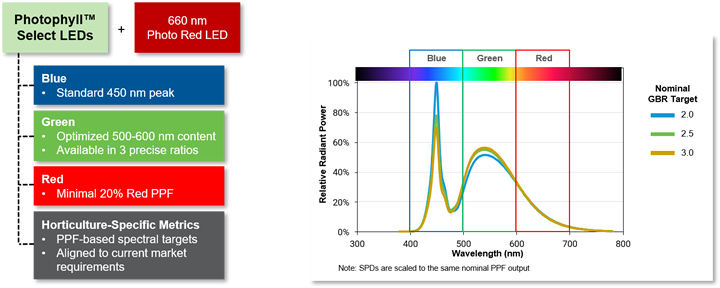Cree LED is the first LED supplier to fully characterize products in horticulture metrics, such as PPF and Red PPF %, instead of lighting metrics, such as CCT and CRI.
![Horticulture LEDs and Photophyll™ Select LED]() Horticulture LEDs and Photophyll™ Select LED
Horticulture LEDs and Photophyll™ Select LED

Q&A with Morgan Meadows Davis, Product Manager | CREE LED
Tell us about yourself and your role with Cree LED.
Morgan Meadows Davis, I currently serve as a Product Manager at Cree LED. I am responsible for multiple high-power LED portfolios as well as new product introductions and customer engagement. I joined Cree LED in 2013 and have held positions in process integration and LED product development. Currently I am responsible for the horticulture market and Cree LED’s XLamp® horticulture products.
Can LEDs improve agriculture growth/yield?
LEDs bring higher efficiency than HPS lights meaning more useable light energy is available to the plants for a given power load. More light generally means higher yields. They also offer a wide variety of wavelengths allowing optimization / customization of their spectrum. Different LED colors or combination of LED colors may be used during different growth cycles of plants, across different crop types and across varying growing environments.
LEDs have enabled small form factor luminaires for new lighting designs and applications such as vertical farming and intra-canopy illumination. LEDs do not heat up the plants as much as earlier technologies, so lights can be placed closers to plants than ever before.
Figure 1: Spectral Power Distribution Graphs of LED Colors Available from Cree LED
Tell us about Photophyll™ Select LEDs and why agriculture experts are excited about them?
Photophyll Select LEDs deliver an advanced spectrum that gives precise control over the green/blue ratio. They have a minimized and stable red content to allow for maximum contribution from the more efficient 660 nm Photo Red LEDs. Currently our Photophyll Select LEDs maintain a red content of 20%. Customers may then choose a green-blue ratio from 2 to 3 for their LED. All previous LEDs were binned, at least partially, for human vision applications and did not offer this level of precise, direct control over the horticulture ratios.
Figure 2: Cree LED Photophyll™ Select LEDs are Optimized for High Performance Horticulture Lighting

Our reference design utilizing 2 LED Channels, Photophyll + 660 nm Photo Red, gives better performance (up to 6% efficacy improvement) and 33% lower LED count while maintaining same GBR and red % at the same input power.
Figure 3: Cree LED Reference Design Horticulture Linear Luminaire
How does Cree LED address the unique requirements of horticulture?
Plants respond to light differently than humans, so it doesn’t make sense to characterize LEDs for horticulture in terms of human vision. Cree LED is the first LED supplier to fully characterize products in horticulture metrics, such as PPF and Red PPF %, instead of lighting metrics, such as CCT and CRI.
We extended our design tools to support mixing different colors together and simulating the results in horticulture metrics. We help customers estimate their luminaire performance before building a prototype system to speed up their design cycle.
Horticulture applications are harsher environments and uniquely expose materials to high levels of sulfur. Based on customer feedback, we are upgrading all our XLamp High Power Horticulture products for higher robustness to sulfur by end of the year.
What does “optimized for horticulture applications” mean?
Plants don’t utilize light the same way humans see it. Optimizing for horticulture means focusing on parameters specific to plants.
Photophyll is a great example of this. Where standard white LEDs are selected based on CCT/CRI parameters, Photophyll is based on optimizing the GBR.
Look into the future a few years, what advancements in LEDs are to come?
I believe we will see continued improvement of the overall PPE of horticulture LEDs. Today’s horticulture LEDs are in the 50-80% efficiency range, so there are still improvements that can be made to further increase efficiency.
Also, customized LED lens shapes to address target and customer-specific applications with different light emission patterns. This customization currently happens at the luminaire level with secondary optics made of plastic or glass, but these materials cost light output and efficiency. If the job of shaping the light output can be done by the LED component itself, then the overall luminaire efficiency can be increased and the luminaire cost reduced.
The content & opinions in this article are the author’s and do not necessarily represent the views of AgriTechTomorrow

Cree LED
Cree LED offers one of the industry's broadest portfolios of application-optimized LED chips and components, leading the industry in performance and reliability. Our team delivers best-in-class technology and breakthrough solutions for focused applications in high power and mid-power general lighting, specialty lighting and video screens. With more than thirty years of experience, Cree LED develops products backed by expert design assistance, superior sales support and industry-best global customer service.
Other Articles
Revolutionizing Growth: How Advanced Lighting Solutions are Transforming Vertical Farms and Greenhouses
More about Cree LED
Comments (0)
This post does not have any comments. Be the first to leave a comment below.
Featured Product

